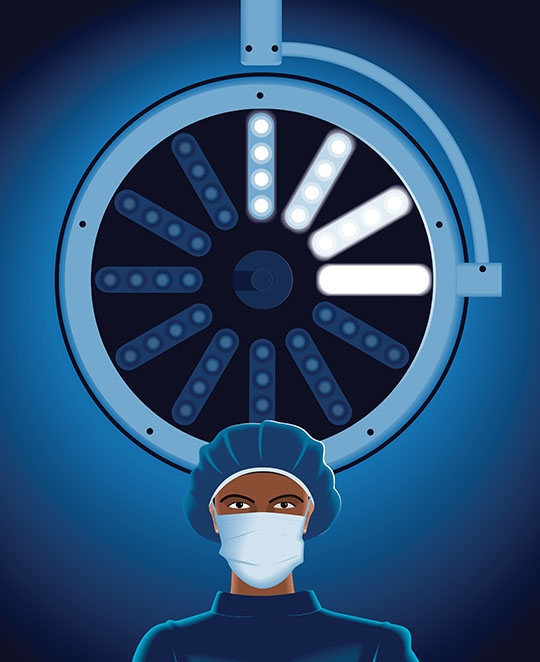Learning to Work with Intelligent Machines

如今在岗学习面临挑战。复杂分析技术、人工智能和机器人突然闯入了职场的方方面面,从根本上颠覆了这一由来已久的有效学习方式。随着技术让工作越来越自动化,每年都有数以万计的人离职或就业,数以亿计的人必须学习新技能和新工作方式。但更广泛的证据表明,公司部署智能机器会阻碍这一关键的学习渠道:我和我的同事发现,人工智能会让新手失去学习机会,让老手减少实践机会,迫使两者必须同时掌握新方法和旧方法,令他们不堪重负。
Today OJL is under threat. The headlong introduction of sophisticated analytics, AI, and robotics into many aspects of work is fundamentally disrupting this time-honored and effective approach. Tens of thousands of people will lose or gain jobs every year as those technologies automate work, and hundreds of millions will have to learn new skills and ways of working. Yet broad evidence demonstrates that companies’ deployment of intelligent machines often blocks this critical learning pathway: My colleagues and I have found that it moves trainees away from learning opportunities and experts away from the action, and overloads both with a mandate to master old and new methods simultaneously.
那么,员工能否学会和这些机器共事呢?此前的一些观察来自参与挑战常规实践的学习者,这些实践并非重点,而且人们对其结果的容忍度高。我将这一广泛存在且非正式的流程称为“暗中学习”。
How, then, will employees learn to work alongside these machines? Early indications come from observing learners engaged in norm-challenging practices that are pursued out of the limelight and tolerated for the results they produce. I call this widespread and informal process shadow learning.
学习的障碍
Obstacles to Learning
我发现了获取所需技能的四大普遍障碍。这些障碍触发了暗中学习。
I’ve identified four widespread obstacles to acquiring needed skills. Those obstacles drive shadow learning.
1. 新手正在失去“学习优势”
1. Trainees are being moved away from their “learning edge.”
在任何工作中,培训员工都会产生成本并降低质量,因为新手行动缓慢且易犯错。正如克里斯汀所发现的那样,组织迎来智能机器,通常会让受培训者减少参与风险和复杂度高的部分,以此作为管理之策。因此,受培训者将无法获得扩充能力范围边界,并在有限帮助下从错误中成长的机会——而这些恰恰是学习新技能的必要条件。
Training people in any kind of work can incur costs and decrease quality, because novices move slowly and make mistakes. As organizations introduce intelligent machines, they often manage this by reducing trainees’ participation in the risky and complex portions of the work, as Kristen found. Thus trainees are being kept from situations in which they struggle near the boundaries of their capabilities and recover from mistakes with limited help—a requirement for learning new skills.
投资银行里也有同样现象。纽约大学的卡伦·安东尼(Callen Anthony)在某投行中发现,合伙人用算法来协助公司并购并解读估值,使得初级分析师与高级合伙人越离越远。初级分析师的任务仅是从系统中提取原始报告(在网络上对感兴趣公司的财务数据进行收集),然后将其传递给高级合伙人进行分析。
The same phenomenon can be seen in investment banking New York University’s Callen Anthony found that junior analysts in one firm were increasingly being separated from senior partners as those partners interpreted algorithm-assisted company valuations in M&As. The junior analysts were tasked with simply pulling raw reports from systems that scraped the web for financial data on companies of interest and passing them to the senior partners for analysis.
这种分工的隐含逻辑是什么?首先,降低初级员工在面向客户的复杂工作中犯错的风险;第二,最大化高级合伙人的效率:向初级员工解释工作的时间越少,他们就越能专注于更高级别的分析。这样做短期内效率有所提高,但却剥夺了初级分析师挑战复杂工作的机会,使他们更难以了解整个估值过程,并削弱了公司未来的能力。
The implicit rationale for this division of labor? First, reduce the risk that junior people would make mistakes in doing sophisticated work close to the customer; and second, maximize senior partners’ efficiency: The less time they needed to explain the work to junior staffers, the more they could focus on their higher-level analysis. This provided some short-term gains in efficiency, but it moved junior analysts away from challenging, complex work, making it harder for them to learn the entire valuation process and diminishing the firm’s future capability.
2. 专家与工作疏远了
2. Experts are being distanced from the work.
有时,智能机器会夹在受培训者和工作之间,有时则妨碍专家进行重要实践工作。机器人操作的手术中,外科医生在手术过程的大多数时间都看不到患者的身体或机器人,因此无法直接评估和管理关键环节。例如,在传统手术中,外科医生会敏锐地意识到装置和器械如何碰触患者的身体并进行相应调整。但是在机器人手术中,如果机器臂撞到病人的头部,或者清洁臂即将替换器械,外科医生必须依靠他人提醒才能知道。这对学习有两重影响:外科医生无法磨练全面了解自己工作所需的技能,以及必须通过他人才能获得此类新技能。
Sometimes intelligent machines get between trainees and the job, and other times they’re deployed in a way that prevents experts from doing important hands-on work. In robotic surgery, surgeons don’t see the patient’s body or the robot for most of the procedure, so they can’t directly assess and manage critical parts of it. For example, in traditional surgery, the surgeon would be acutely aware of how devices and instruments impinged on the patient’s body and would adjust accordingly; but in robotic surgery, if a robot’s arm hits a patient’s head or a scrub is about to swap a robotic instrument, the surgeon won’t know unless someone tells her. This has two learning implications: Surgeons can’t practice the skills needed to make holistic sense of the work on their own, and they must build new skills related to making sense of the work through others.
3.学习者必须掌握新旧两种方法。
3. Learners are expected to master both old and new methods.
机器人手术用一套全新的技巧和技术来实现传统手术试图达到的效果。它保证更高的精确度和更优人体工程学,直接被纳入了课程中,住院医生被要求学习机器人知识和传统方法。但课程没有足够的时间让他们两者兼通,这往往会导致最坏的结果:哪种都没有掌握。我将这一难题称为方法超载(methodological overload)。
Robotic surgery comprises a radically new set of techniques and technologies for accomplishing the same ends that traditional surgery seeks to achieve. Promising greater precision and ergonomics, it was simply added to the curriculum, and residents were expected to learn robotic as well as open approaches. But the curriculum didn’t include enough time to learn both thoroughly, which often led to a worst-case outcome: The residents mastered neither. I call this problem methodological overload.
4.标准学习方法被默认为有效。
4. Standard learning methods are presumed to be effective.
几十年的研究和传统让实习医生遵循“看一、做一、教一”的方法。但如我们所见,它不适应机器人手术。尽管如此,依赖老派学习方法的压力非常大,“离经叛道”者寥寥:外科培训研究、标准程序、政策和高级外科医生都继续强调传统的学习方法,哪怕该方法显然已不适用于机器人手术。
Decades of research and tradition hold trainees in medicine to the See one, do one, teach one method, but as we’ve seen, it doesn’t adapt well to robotic surgery. Nonetheless, pressure to rely on approved learning methods is so strong that deviation is rare: Surgical-training research, standard routines, policy, and senior surgeons all continue to emphasize traditional approaches to learning, even though the method clearly needs updating for robotic surgery.
暗中学习
Shadow Learning Responses
面临上述阻碍,暗中学习者悄悄绕过或打破规则来获得所需的指导和经验,自然不足为奇。约100年前,社会学家罗伯特·莫顿(Robert Merton)就发现,当合法手段对达成有价值的目标不再奏效时,就会出现非常手段。对于专业知识(或许是职业的终极目标)也不例外。
Faced with such barriers, shadow learners are bending or breaking the rules out of view to get the instruction and experience they need. We shouldn’t be surprised. Close to a hundred years ago, the sociologist Robert Merton showed that when legitimate means are no longer effective for achieving a valued goal, deviance results. Expertise—perhaps the ultimate occupational goal—is no exception。
鉴于我描述的障碍,我们应理解人们会采取其他方式学习关键技能。这些方式一般灵活有效,却往往会让个人和组织付出代价:暗中学习者可能会受到惩罚,例如失去实践机会或地位或造成浪费甚至构成伤害。但人们依然一再铤而走险,因为当合规的方式失败时,他们的学习方法奏效。不加鉴别地效仿这些非常手段自然不对,但它们确实有组织值得学习之处。
Given the barriers I’ve described, we should expect people to find deviant ways to learn key skills. Their approaches are often ingenious and effective, but they can take a personal and an organizational toll: Shadow learners may be punished (for example, by losing practice opportunities and status) or cause waste and even harm. Still, people repeatedly take those risks, because their learning methods work well where approved means fail. It’s almost always a bad idea to uncritically copy these deviant practices, but organizations do need to learn from them.
1. 持续学习
1. Keep studying it.
随着智能技术变得更强大,暗中学习也在迅速发展。新形式将随着时间的推移而出现,提供新的经验。保持谨慎至关重要。暗中学习者经常意识到他们的做法不符合常规,并且他们可能因为自己的做法而受到惩罚。(试想如果一位外科住院医生让别人知道他/她想找最不熟练的主治医师合作。)因为能产生效果,只要暗中学习者不公开承认,中层管理者经常对这些做法视而不见。当观察者,特别是高级管理者宣布想研究员工如何靠违反规则来获得技能时,学习者及其管理者可能不愿意分享经验。比较好的解决方案是,引入中立的第三方,可以确保严格的匿名性,同时比较不同案例的做法。我的线人开始了解并信任我,他们意识到我在许多工作组和设施中观察工作,因此他们确信自己的身份会受到保护。这对于让他们说出真相至关重要。
Shadow learning is evolving rapidly as intelligent technologies become more capable. New forms will emerge over time, offering new lessons. A cautious approach is critical. Shadow learners often realize that their practices are deviant and that they could be penalized for pursuing them. (Imagine if a surgical resident made it known that he sought out the least-skilled attendings to work with.) And middle managers often turn a blind eye to these practices because of the results they produce—as long as the shadow learning isn’t openly acknowledged. Thus learners and their managers may be less than forthcoming when an observer, particularly a senior manager, declares that he wants to study how employees are breaking the rules to build skills. A good solution is to bring in a neutral third party who can ensure strict anonymity while comparing practices across diverse cases. My informants came to know and trust me, and they were aware that I was observing work in numerous work groups and facilities, so they felt confident that their identities would be protected. That proved essential in getting them to open up.
2. 调整你发现的暗中学习实践来适应构建组织、工作和技术
2. Adapt the shadow learning practices you find to design organizations, work, and technology.
组织对智能机器的处置往往停留在让个别专家控制工作,减少对受训者依赖的层面。机器人手术系统允许高级外科医生在较少的帮助下操作,他们照做了。投资银行系统允许高级合伙人将初级分析师从复杂的估值工作中排除,他们也照做了。所有利益相关者都应坚持让组织,技术和工作设计提高生产力和加强OJL。例如,在洛杉矶警察局中,这将意味着改变对巡警的激励措施,重新设计PredPol用户界面,创建新角色来连接警察和软件工程师,以及由警察发起建立带注释的最佳实践案例库。
Organizations have often handled intelligent machines in ways that make it easier for a single expert to take more control of the work, reducing dependence on trainees’ help. Robotic surgical systems allow senior surgeons to operate with less assistance, so they do. Investment banking systems allow senior partners to exclude junior analysts from complex valuations, so they do. All stakeholders should insist on organizational, technological, and work designs that improve productivity and enhance on-the-job learning. In the LAPD, for example, this would mean moving beyond changing incentives for beat cops to efforts such as redesigning the PredPol user interface, creating new roles to bridge police officers and software engineers, and establishing a cop-curated repository for annotated best practice use cases.
3.使智能机器成为解决方案的一部分
3. Make intelligent machines part of the solution.
人工智能可以在学习者遇到难题时提供帮助,为作为导师的专家提供培训,并巧妙地连接这两个群体。例如,金柱赫(Juho Kim)在麻省理工学院读博时建立了ToolScape和Lecture-Scape,可以众包方式为教学视频加注释,并为之前暂停寻找注释的用户提供澄清解释和机会。他将之称为学习者采购。在硬件方面,增强现实系统开始将专家指导和注释带入工作流中。
AI can be built to coach learners as they struggle, coach experts on their mentorship, and connect those two groups in smart ways. For example, when Juho Kim was a doctoral student at MIT, he built ToolScape and LectureScape, which allow for crowdsourced annotation of instructional videos and provide clarification and opportunities for practice where many prior users have paused to look for them. He called this learnersourcing. On the hardware side, augmented reality systems are beginning to bring expert instruction and annotation right into the flow of work.
现有应用程序使用平板电脑或智能眼镜,将指导实时添加到工作上。预计很快就会有更复杂的智能系统。例如,这样的系统可以在学徒焊工的视野中叠加工厂中模范焊工的录像,显示工作如何完成,记录学徒的尝试与之对比,并根据需要将学徒与模范焊工联系起来。这些领域不断增长的工程师社区大多专注于正式培训,更深层次的危机是OJL。我们需要重新分配在OJL上的精力。
Existing applications use tablets or smart glasses to overlay instructions on work in real time. More-sophisticated intelligent systems are expected soon. Such systems might, for example, superimpose a recording of the best welder in the factory on an apprentice welder’s visual field to show how the job is done, record the apprentice’s attempt to match it, and connect the apprentice to the welder as needed. The growing community of engineers in these domains have mostly been focused on formal training, and the deeper crisis is in on-the-job learning. We need to redirect our efforts there.
几千年来,技术的进步推动了工作流程的重新设计,学徒们从导师那里获得了必要的新技能。但正如我们所见,现在智能机器正以生产率为名,迫使我们让学徒与导师脱离,让导师与工作脱离。组织通常在不经意间选择生产率而非员工参与,因此在工作中学习变得越来越困难。然而,暗中学习者正在寻找有风险、打破常规的学习方法。想在智能机器世界中竞争的组织应该密切关注这些“不按常理出牌的人”。他们的行动可以让你深入了解,当未来专家、学徒和智能机器共同工作和学习时,如何以最佳方式完成工作。
For thousands of years, advances in technology have driven the redesign of work processes, and apprentices have learned necessary new skills from mentors. But as we’ve seen, intelligent machines now motivate us to peel apprentices away from masters, and masters from the work itself, all in the name of productivity. Organizations often unwittingly choose productivity over considered human involvement, and learning on the job is getting harder as a result. Shadow learners are nevertheless finding risky, rule-breaking ways to learn. Organizations that hope to compete in a world filling with increasingly intelligent machines should pay close attention to these “deviants.” Their actions provide insight into how the best work will be done in the future, when experts, apprentices, and intelligent machines work, and learn, together.
马特·比恩(Matt Beane)|文
马特·比恩是加州大学圣巴巴拉分校技术管理助理教授,也是麻省理工学院数字经济项目研究成员。
刘铮筝 | 译 蒋荟蓉 | 校 周强|编辑




